
Cirkit Designer
Your all-in-one circuit design IDE
Home /
Component Documentation
How to Use tds probe: Examples, Pinouts, and Specs
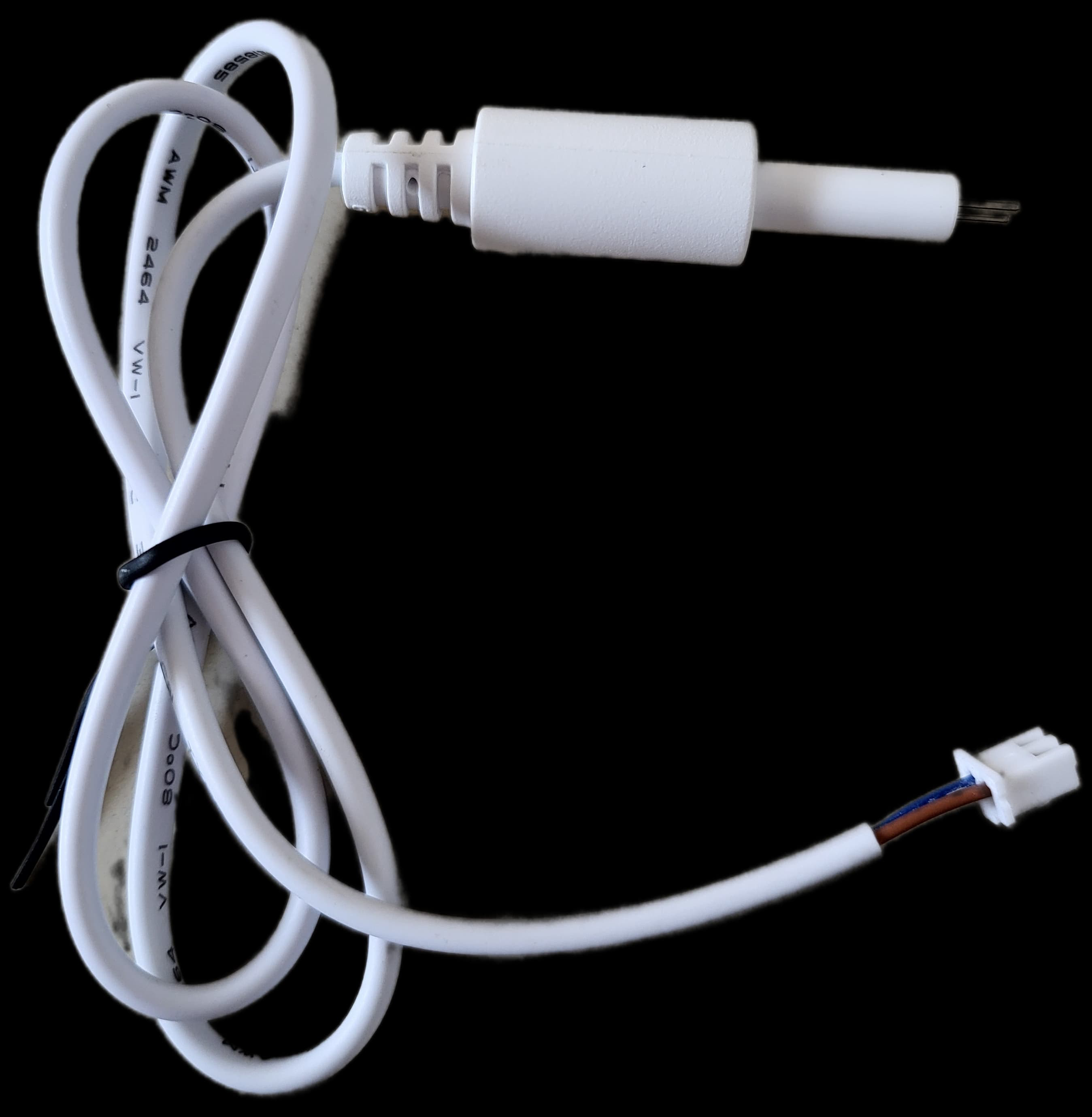
 Design with tds probe in Cirkit Designer
Design with tds probe in Cirkit DesignerIntroduction
A TDS (Total Dissolved Solids) probe is a sensor used to measure the concentration of dissolved solids in a liquid, typically water. It is commonly used in water quality testing, aquariums, hydroponics, and various industrial applications. The TDS value is an important parameter for assessing the purity of water and ensuring it meets specific standards for various uses.
Explore Projects Built with tds probe
ESP32-Based TDS Meter for Water Quality Monitoring
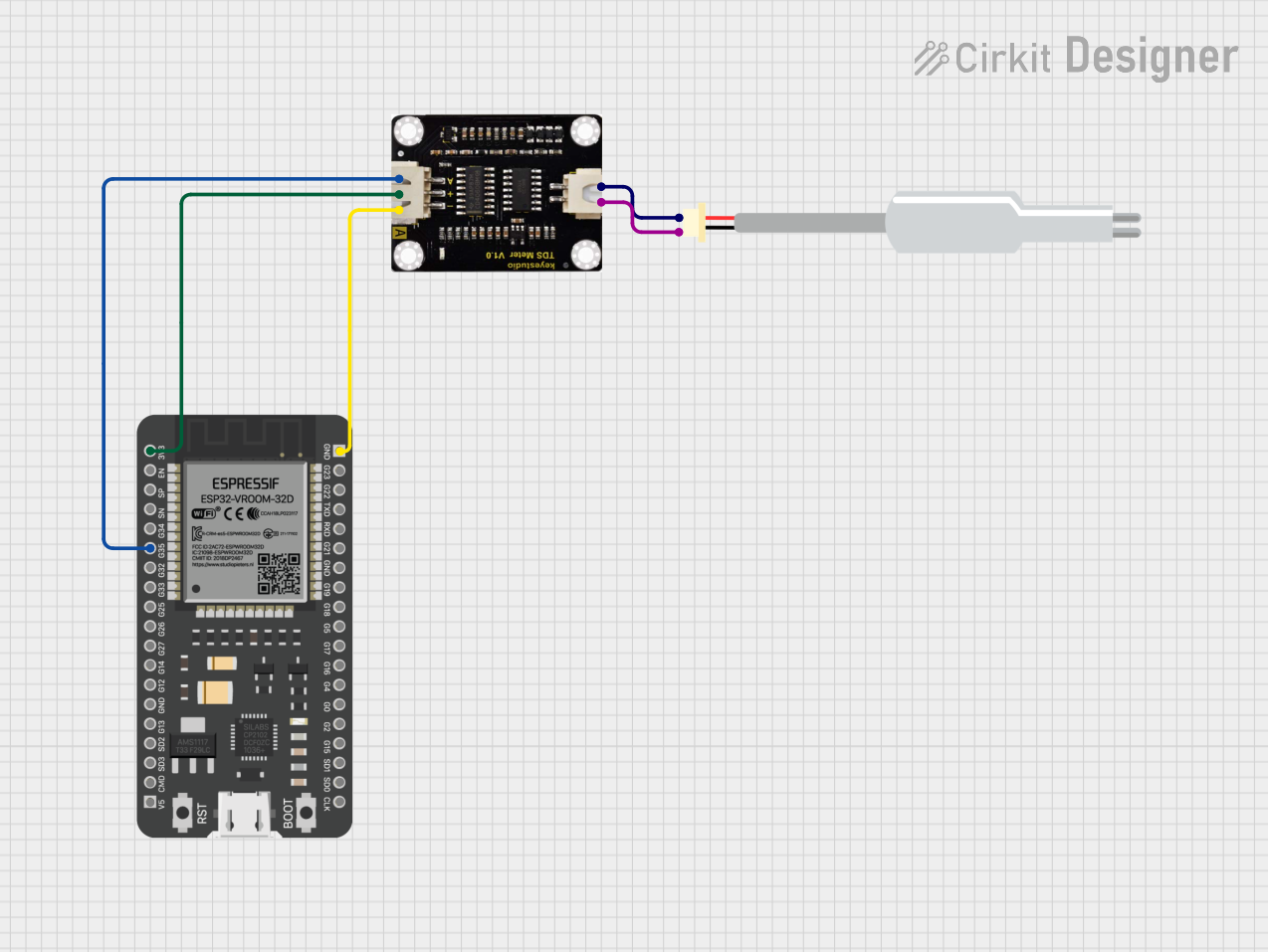
This circuit connects a TDS (Total Dissolved Solids) sensor to an ESP32 microcontroller. The TDS sensor's power is supplied by the ESP32's 3.3V and ground pins, and its analog output is connected to GPIO 35 of the ESP32 for measurement. The purpose of this circuit is to enable the ESP32 to read the TDS level of a solution, which is commonly used in water quality testing.
 Open Project in Cirkit Designer
Open Project in Cirkit DesignerESP32-Based Water Quality Monitoring System with DS18B20 and Turbidity Sensor
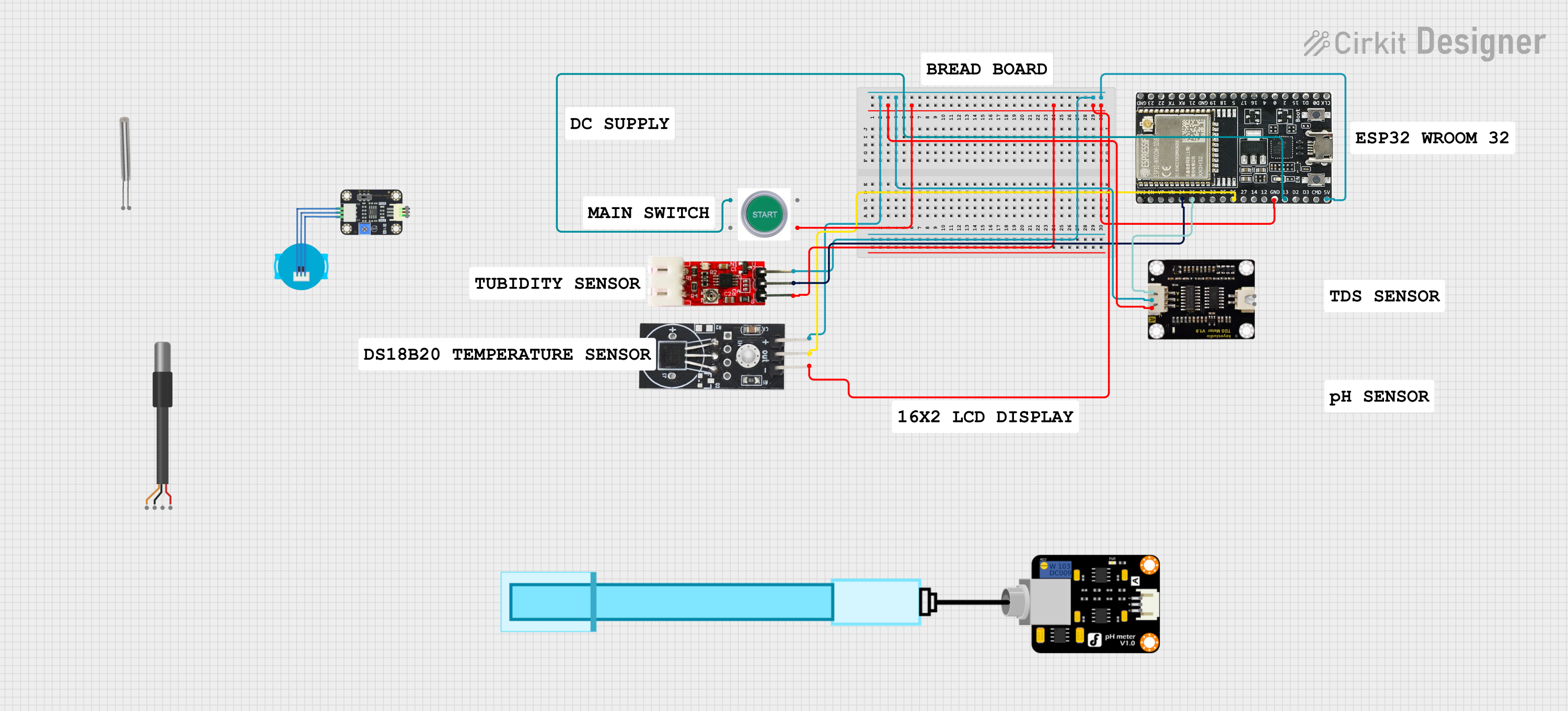
This circuit is a water quality monitoring system that uses an ESP32 microcontroller to measure TDS, pH, temperature, and turbidity of water. The system includes sensors for each parameter and a start switch, with data being displayed on a 16x2 I2C LCD and logged via serial communication.
 Open Project in Cirkit Designer
Open Project in Cirkit DesignerArduino Leonardo-Based pH and TDS Sensor with OLED Display
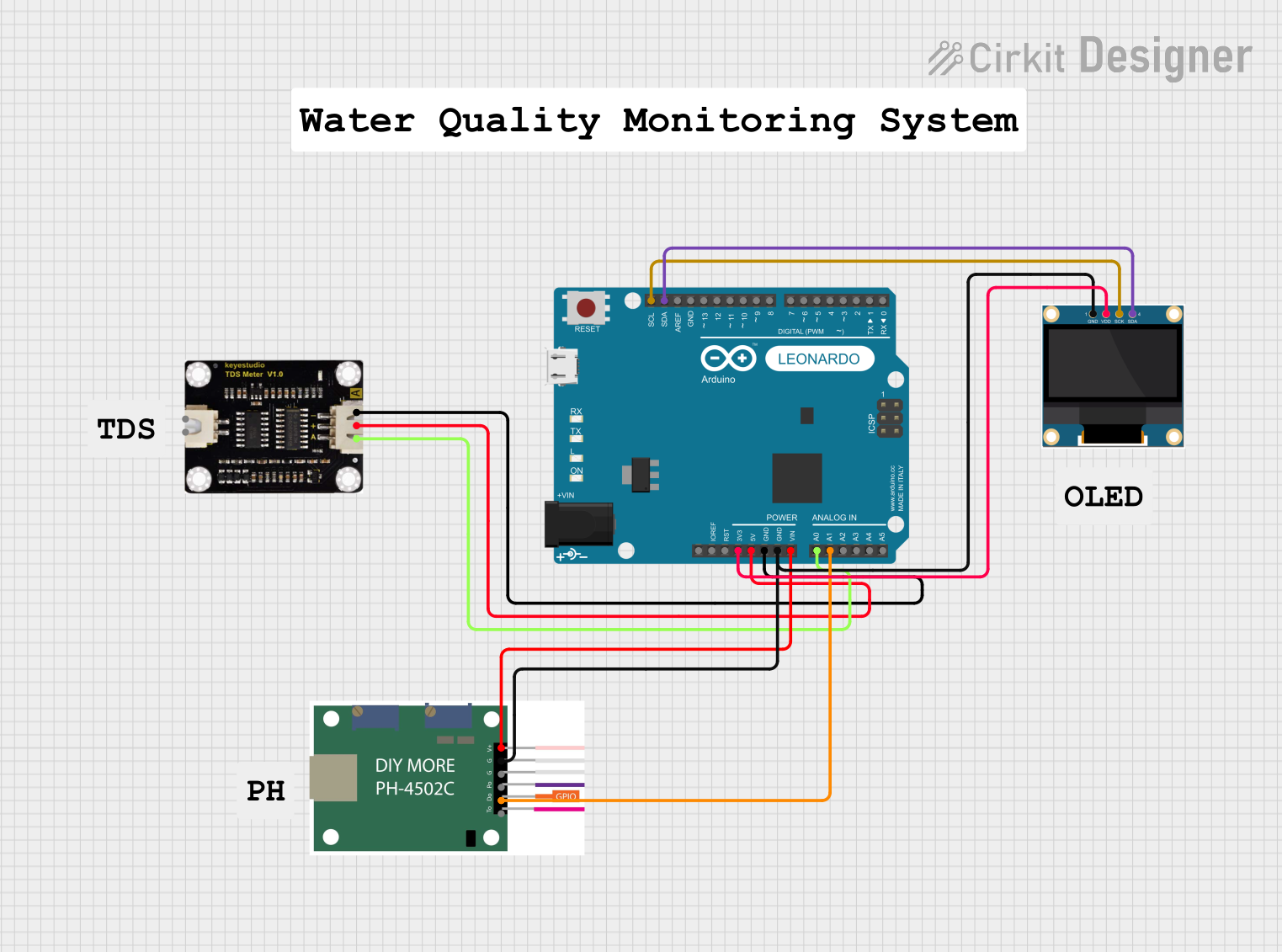
This circuit is designed to measure pH and TDS (Total Dissolved Solids) levels in a solution using a pH sensor and a TDS sensor, respectively, interfaced with an Arduino Leonardo. The measured data is then displayed on a 0.96" OLED screen.
 Open Project in Cirkit Designer
Open Project in Cirkit DesignerESP32-Based Environmental Monitoring System with Wi-Fi Connectivity
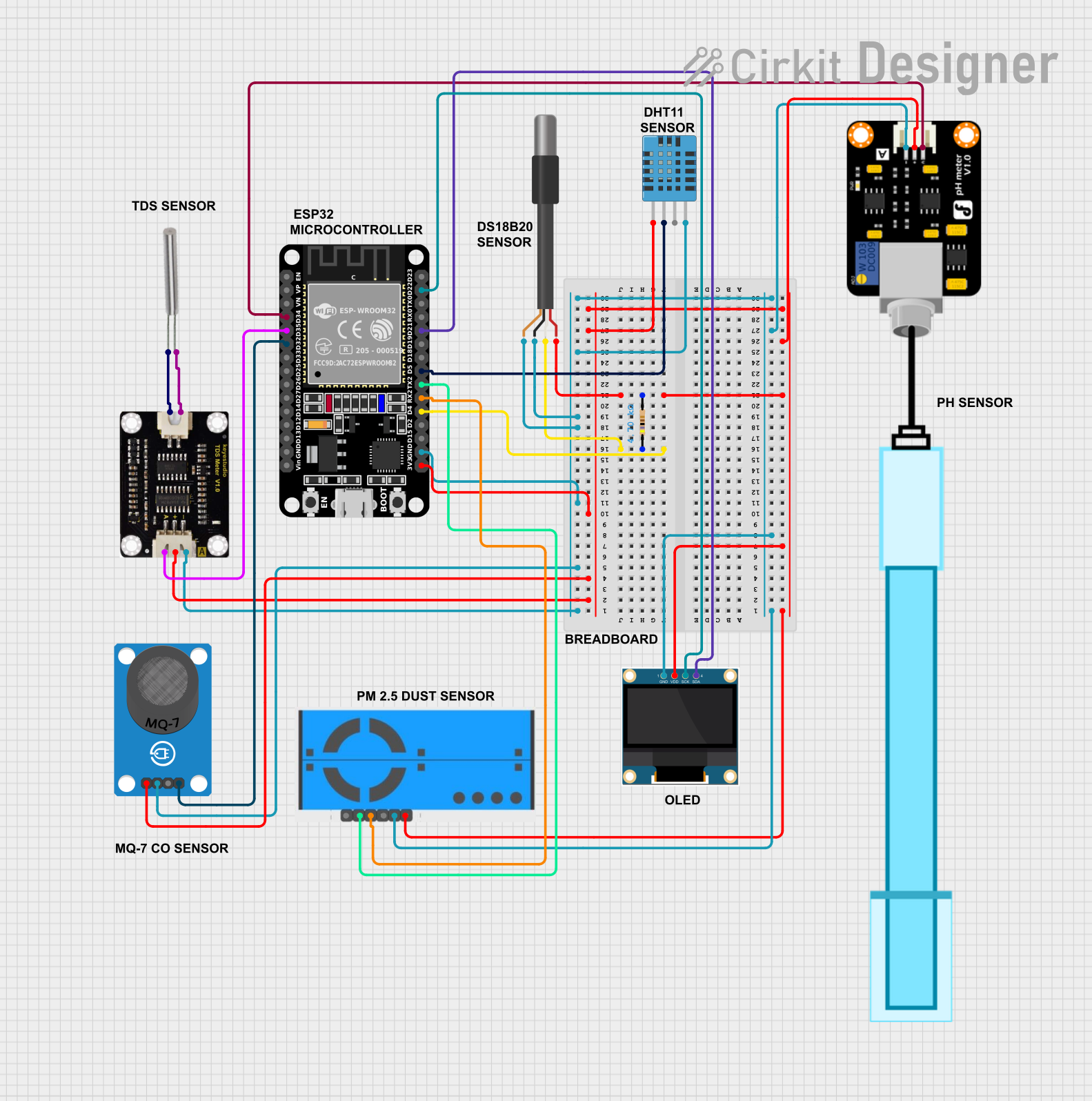
This circuit is an environmental monitoring system using an ESP32 microcontroller to collect data from various sensors, including temperature, humidity, air quality, pH, and TDS sensors. The collected data is displayed on an OLED screen, sent to ThingSpeak for remote monitoring, and email alerts are sent if critical thresholds are exceeded.
 Open Project in Cirkit Designer
Open Project in Cirkit DesignerExplore Projects Built with tds probe

ESP32-Based TDS Meter for Water Quality Monitoring
This circuit connects a TDS (Total Dissolved Solids) sensor to an ESP32 microcontroller. The TDS sensor's power is supplied by the ESP32's 3.3V and ground pins, and its analog output is connected to GPIO 35 of the ESP32 for measurement. The purpose of this circuit is to enable the ESP32 to read the TDS level of a solution, which is commonly used in water quality testing.
 Open Project in Cirkit Designer
Open Project in Cirkit Designer
ESP32-Based Water Quality Monitoring System with DS18B20 and Turbidity Sensor
This circuit is a water quality monitoring system that uses an ESP32 microcontroller to measure TDS, pH, temperature, and turbidity of water. The system includes sensors for each parameter and a start switch, with data being displayed on a 16x2 I2C LCD and logged via serial communication.
 Open Project in Cirkit Designer
Open Project in Cirkit Designer
Arduino Leonardo-Based pH and TDS Sensor with OLED Display
This circuit is designed to measure pH and TDS (Total Dissolved Solids) levels in a solution using a pH sensor and a TDS sensor, respectively, interfaced with an Arduino Leonardo. The measured data is then displayed on a 0.96" OLED screen.
 Open Project in Cirkit Designer
Open Project in Cirkit Designer
ESP32-Based Environmental Monitoring System with Wi-Fi Connectivity
This circuit is an environmental monitoring system using an ESP32 microcontroller to collect data from various sensors, including temperature, humidity, air quality, pH, and TDS sensors. The collected data is displayed on an OLED screen, sent to ThingSpeak for remote monitoring, and email alerts are sent if critical thresholds are exceeded.
 Open Project in Cirkit Designer
Open Project in Cirkit DesignerTechnical Specifications
Key Technical Details
| Parameter | Value |
|---|---|
| Operating Voltage | 3.3V - 5V |
| Operating Current | 3mA |
| Measurement Range | 0 - 1000 ppm |
| Accuracy | ± 10% |
| Temperature Range | 0°C - 60°C |
| Output Type | Analog |
Pin Configuration and Descriptions
| Pin Number | Pin Name | Description |
|---|---|---|
| 1 | VCC | Power supply (3.3V - 5V) |
| 2 | GND | Ground |
| 3 | AOUT | Analog output signal proportional to TDS value |
Usage Instructions
How to Use the Component in a Circuit
- Power Supply: Connect the VCC pin to a 3.3V or 5V power supply.
- Ground: Connect the GND pin to the ground of the power supply.
- Analog Output: Connect the AOUT pin to an analog input pin on a microcontroller (e.g., Arduino).
Example Circuit Diagram
+-------------------+
| |
| TDS Probe |
| |
| +-----+-----+ |
| | VCC | GND | |
| +-----+-----+ |
| | | |
| | | |
+-------|-----|-----+
| |
5V GND
| |
| |
+-------|-----|-----+
| | | |
| Arduino UNO |
| |
| +-----+-----+ |
| | A0 | GND | |
| +-----+-----+ |
| | |
| | |
+-------|-----------+
|
AOUT
Important Considerations and Best Practices
- Calibration: Regularly calibrate the TDS probe using a standard solution to ensure accurate readings.
- Temperature Compensation: TDS readings can be affected by temperature. Use a temperature sensor for compensation if high accuracy is required.
- Cleaning: Keep the probe clean to avoid contamination and ensure accurate measurements. Rinse with distilled water after each use.
- Avoid Air Bubbles: Ensure there are no air bubbles on the probe surface during measurement, as this can affect the readings.
Sample Arduino Code
// TDS Probe Example Code for Arduino UNO
const int TDS_PIN = A0; // Analog pin connected to TDS probe
float voltage, tdsValue;
void setup() {
Serial.begin(9600); // Initialize serial communication
}
void loop() {
int sensorValue = analogRead(TDS_PIN); // Read analog value from TDS probe
voltage = sensorValue * (5.0 / 1023.0); // Convert analog value to voltage
tdsValue = (133.42 * voltage * voltage * voltage - 255.86 * voltage * voltage
+ 857.39 * voltage) * 0.5; // Convert voltage to TDS value (ppm)
Serial.print("TDS Value: ");
Serial.print(tdsValue);
Serial.println(" ppm");
delay(1000); // Wait for 1 second before next reading
}
Troubleshooting and FAQs
Common Issues Users Might Face
Inaccurate Readings:
- Solution: Ensure the probe is calibrated correctly. Check for any contamination or air bubbles on the probe surface.
No Output Signal:
- Solution: Verify the connections. Ensure the power supply voltage is within the specified range (3.3V - 5V).
Fluctuating Readings:
- Solution: Stabilize the liquid sample. Ensure the probe is fully submerged and there are no air bubbles.
FAQs
Q1: How often should I calibrate the TDS probe?
- A1: It is recommended to calibrate the TDS probe at least once a month or whenever you notice inconsistent readings.
Q2: Can I use the TDS probe in hot water?
- A2: The TDS probe is designed to operate within a temperature range of 0°C to 60°C. Using it in hotter water may damage the probe or affect accuracy.
Q3: How do I clean the TDS probe?
- A3: Rinse the probe with distilled water after each use. For thorough cleaning, use a soft brush and mild detergent, then rinse with distilled water.
By following this documentation, users can effectively utilize the TDS probe for accurate water quality measurements in various applications.